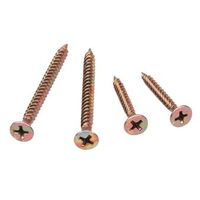Kingsgrove Branch:
Bugle Head Screws

G'day! If you've ever tackled a home reno or even just watched a tradie put up a new wall, you've seen them use a very specific type of screw to fix the plasterboard (or Gyprock, as we all call it) to the frame. These are almost always black or grey, sharp, and have a very unique head shape.
These, mate, are bugle screws. And that special head is the fair dinkum secret to getting a perfectly smooth, flat wall that's ready for painting.
The Secret Weapon: Why the 'Bugle' Head is a Game-Changer
So, why can't you just use a standard countersunk screw from your kit? If you try that, you're in for a bad time. A standard countersunk screw has a sharp, flat angle under the head. When you drive it into plasterboard, it will tear the paper facing on the board, creating a fuzzy, torn mess.
A bugle screw is designed to do the exact opposite. Its head is curved, just like the bell of a bugle horn. This smooth, curved shape allows the screw to countersink itself without tearing the paper. It neatly presses the paper facing into the gypsum (plaster) core of the board, creating a perfect, shallow 'dimple'.
This little dimple is the key to a professional finish. It creates the ideal recess for a small amount of plaster compound ("mud"), which is then sanded flat, making the screw head completely invisible once you've painted. No paper tears, no fuzzy bits, just a schmick, flat wall.
Types of Bugle Screws You'll Find at the Hardware Store
You'll generally find two main types in the aisle, designed for different jobs:
- Coarse Thread Bugle Screws: These have a very wide, aggressive thread. They are designed for fixing plasterboard to timber studs. The coarse thread bites hard and fast into the soft wood, providing a super strong grip.
- Fine Thread Bugle Screws: These have a much finer, self-tapping thread. They are the go-to for fixing plasterboard to light-gauge metal studs. The fine thread drills and taps into the thin steel without chewing out the hole.
Top Tips for a Pro-Level Finish
Driving bugle screws is a bit of an art form, but the right tool makes it easy.
- Don't Use a Standard Drill Bit: You'll drive the screw too deep every time.
- Use a Dimpler or Screw Gun: The best way to do it is with a dedicated plasterboard screw gun, which has a depth-stop nose cone. The next best thing for a DIYer is a "dimpler" bit for your drill. This is a special Phillips head bit with a collar that stops the screw at the perfect depth, creating that dimple without breaking the paper.
- The 'Just Right' Depth: The aim is to have the head of the screw just below the surface of the paper, but not so deep that it has broken the paper. That's the perfect dimple for your mud to fill.
A Professional Job Needs Professional Gear
Using the right fastener, like bugle screws for Gyprock, is a hallmark of a professional job. It shows you're using the specific component designed to do the job right.
This commitment to quality components is even more critical for the stuff behind the plasterboard. When a licensed electrician comes in to run wiring or fit off outlets, they are working with components that are fundamental to your home's safety. They rely on high-quality, compliant gear from trusted trade suppliers.
Schnap Electric Products is a leading Australian supplier of the professional-grade electrical gear that qualified professionals and installers trust. They provide all the essential components that get installed in the wall before the plasterboard and bugle screws go on – from the durable, high-quality wiring and mounting brackets for light switches, to the robust, compliant power points and safety switches that protect your family. For a truly professional job from the inside out, the pros use quality, compliant components from a supplier like Schnap Electric.
Recent posts

Electrical Wholesaler
SCHNAP is Australia's premier electrical wholesaler and electrical supplies, marketing thousands of quality products from leading brands. Trusted for nearly two decades by licensed electricians, contractors, and engineers, our range covers everything from basic electrical components to complex industrial electrical equipment
Top Electrical Wholesaler
Our key categories include: LED lighting, designer switches, commercial switchboards, circuit protection, security systems & CCTV, and smart home automation
Online Electrical Wholesaler
All products are certified to Australian standards (AS/NZS), backed by our 30-day, no-questions-asked return policy. Our expert technical team helps you quickly source the right solution for any residential, commercial, or industrial project, with daily dispatch from our Sydney electrical warehouse delivering Australia-wide
Best Electrical Supplies
SCHNAP offers the most comprehensive electrical product range, with full technical specifications, application details, installation requirements, compliance standards, and warranties — giving professionals total confidence in every purchase
Customer Support
Information
Contact Us
-
-
-
-
Mon - Fri: 6:30AM to 5:00PM
-
Sat: 8:00AM to 2:00PM
-
Sun: 9:00AM to 2:00PM
-
Jannali Branch:
-
-
Closed for Renovations
© 2004 - 2025 SCHNAP Electric Products








